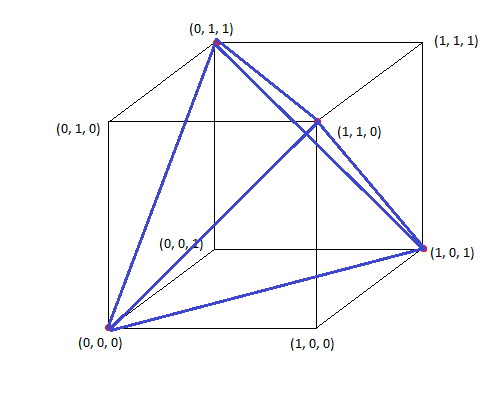The tetrahedron is a captivating geometric shape that belongs to the family of polyhedra. Its name stems from the Greek words “tetráedron,” which means “triangle-based pyramid.” A tetrahedron is a three-dimensional figure with four faces, six edges, and four vertices. All of its faces are equilateral triangles, and one of these triangles serves as the base, while the other three form a pyramid. Consequently, the tetrahedron is often referred to as a triangular pyramid.
What is a Tetrahedron?
A tetrahedron is a three-dimensional geometric figure, also known as a polyhedron, distinguished by its four triangular faces, six straight edges, and four vertex corners One of the triangles functions as the base, and the other three triangles unite to form a pyramid. The term ‘tetrahedron’ originates from Greek words — ‘tetra’ indicating ‘four’ and ‘hedron’ meaning ‘face.’

Platonic Solids
In the realm of geometry, the tetrahedron is classified as a platonic solid. Platonic solids are regular convex polyhedra, meaning that they have identical faces consisting of congruent convex regular polygons. The five platonic solids include the tetrahedron, cube, octahedron, dodecahedron, and icosahedron. Each of these solids meets the criteria of having congruent faces and vertices, as well as equal edge lengths.

Tetrahedron Characteristics
Let’s delve into the various characteristics of the tetrahedron that make it unique and distinguishable. A tetrahedron has four faces, six edges, and four vertices (corners). All of its vertices are equidistant from each other, making it a regular tetrahedron. Unlike other platonic solids, the tetrahedron does not have parallel faces. Instead, it has four equilateral triangles as its faces, giving it a distinct appearance.
Tetrahedral Structures
Tetrahedrons can be classified into two types: right tetrahedrons and oblique tetrahedrons. A right tetrahedron is formed when the apex of the tetrahedron is positioned directly above the center of the base. On the other hand, an oblique tetrahedron is formed when the apex is not directly above the base’s center. In a right tetrahedron, the line segment from the apex to the middle of the base is perpendicular to the base, representing the height of the tetrahedron.
Regular and Irregular Tetrahedrons
Tetrahedrons can also be categorized as regular or irregular. A regular tetrahedron is one in which all four faces are equilateral triangles. Consequently, all the edges of a regular tetrahedron have equal lengths, making it a proper tetrahedron. An irregular tetrahedron, on the other hand, does not have equilateral triangles as its faces and may have edges of varying lengths.
Regular Tetrahedron Formulas
The regular tetrahedron can be defined mathematically using several formulas:
- Area of One Face: A = (1/4) √3 a²
- Total Surface Area: A = a² √3
- Volume: V = (a³ √2)/12
- Altitude: h = (a √6)/3

Tetrahedron Net
A tetrahedron can be visualized using a geometric net, which is a two-dimensional shape that can be folded to create a three-dimensional figure. By cutting and folding a sheet of paper in a specific manner, we can create a tetrahedron. This technique, known as pyramid packaging, is often used to store liquids such as fruit juice.
Properties of Tetrahedron
To better understand the tetrahedron, let’s explore its properties. A tetrahedron has four faces, six edges, and four vertices. The vertices are the points where the faces intersect, and each face is an equilateral triangle. All four vertices are equidistant from each other, resulting in a symmetrical shape. Additionally, a regular tetrahedron has six planes of symmetry, dividing the shape into mirrored parts.
Surface Area of Tetrahedron
The surface area of a tetrahedron is the total region covered by all its faces. It is measured in square units, such as square centimeters or square inches. The surface area of a tetrahedron can be further divided into two types: the lateral surface area and the total surface area.
Lateral Surface Area of a Tetrahedron
The lateral surface area refers to the area of the lateral or slant faces of a tetrahedron. The formula for the lateral surface area of a regular tetrahedron is: LSA = (3√3/4) a², where ‘a’ is the side length of the regular tetrahedron.

Total Surface Area of a Tetrahedron
The total surface area includes the area of all the faces of a tetrahedron. The formula for this is: TSA = √3 a², where ‘a’ is the side length of the regular tetrahedron.
Volume of Tetrahedron
The volume of a tetrahedron corresponds to the total space it occupies in a three-dimensional plane. It is expressed in cubic units like cm³, m³, in³, ft³, yd³, etc. The formula for calculating the volume of a regular tetrahedron is given as: V = (a³ √2)/12, where ‘a’ is the side length of the regular tetrahedron.
Tetrahedron Angles
In a regular tetrahedron, all the faces are equilateral triangles, meaning that all the interior angles of the tetrahedron are 60 degrees each. The sum of the face angles for three faces meeting at any vertex is 180 degrees.

Solved Examples On Tetrahedron
Let’s look at some examples that elucidate how to apply these formulas:
Example 1: Find the volume of a regular tetrahedron with sides measuring 10 cm.
Solution: Here, ‘a’ = 10 cm. Using the formula for Volume of a Regular Tetrahedron: V = (a³ √2)/12 = (10³ √2)/12 = 117.85 cm³
Example 2: Calculate the total surface area of a regular tetrahedron with edge length 5 cm.
Solution: Here, ‘a’ = 5 cm. Using the formula for Total Surface Area: TSA = √3 a² = √3 (5)² = 43.30 cm²
Example 3: Determine the lateral surface area of a regular tetrahedron with an edge length of 6 cm.
Solution: Here, ‘a’ = 6 cm. Using the formula for Lateral Surface Area: LSA = (3√3/4) a² = (3√3/4) (6)² = 46.76 cm²
In summary, a tetrahedron is a three-dimensional figure showcasing the elegance of geometry. Its unique properties and characteristics render it a mathematical marvel, and its various formulas offer numerous practical applications in the realms of mathematics and physics.
